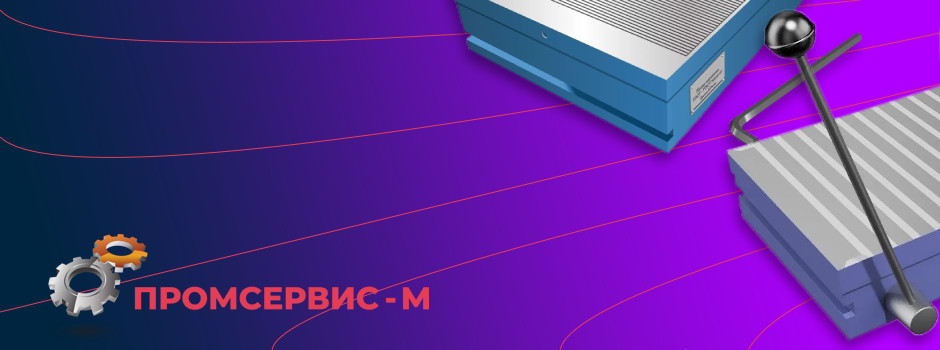
Magnetic plates Промсервис-М
Magnetic plates are accessories that are used on metal–cutting machines in order to hold workpieces or parts during their processing with cutting tools. The plates act on the basis of a magnetic field, thanks to which ferrous metals are attracted and fixed. The method of holding parts is the main difference between magnetic plates and vises (there is no mechanical impact on the surface). The main advantage is that the possibility of damage to the part is excluded. The production of magnetic plates is regulated by GOST 16528-87.
Scope of application of magnetic plates
Magnetic plates are equipped with metalworking machines of various types. The most common mechanism in grinding machines. Magnetic fixation provides maximum access to the surface to be treated, eliminates accidental mechanical damage. Magnetic plates are used on lathes and milling machines - when assembly operations or welding work are carried out.
Magnetic plates are advisable to use when you need to fix a small part. An important advantage of this method of fastening is the accuracy of installation during the entire processing period of the product. Magnetic type plates are rarely included in the basic configuration. They are purchased separately from the machine, taking into account the size of the workpieces being processed, the clamping force and other parameters.
Types and technical characteristics of magnetic plates
According to the type of fixation plates are magnetic and electromagnetic. Structurally, both types of plates are similar – there are two groups of magnets of different polarity. In magnetic plates, the field acts constantly, blocks of non-magnetic material are responsible for the non-working position. When installing the part, the blocks are displaced, so the object is fixed on the work surface.
The main parameter is the size of the plate, which determines the permissible dimensions of the part. The larger the surface size of the magnetic plate, the higher the weight on the desktop.
Main Features:
- Pressing force. Usually from 50 to 120 N/cm2.
- Size and weight. From 100x250mm to 320x1000mm (length and width).
- The distance between the advantages of coils and magnets. Defines the minimum size of the workpiece.
Design features and operation
A magnetic plate consists of magnetic blocks (movable or stationary) and a housing. In movable blocks, you can change the distance between the poles. The structure consists of metal plates with ceramic magnets.
In order for the magnetic blocks to move inside the housing, an eccentric mechanism is provided. Movement control is carried out using the handle. The adjustment unit is located in the electrical cabinet, regulates the frequency of pressing the part. In plates with high power, there is a demagnetization control unit that sends short-term reverse pulses and removes residual magnetization. Without the demagnetization mechanism, it would be difficult to detach the part from the surface.
During operation, the magnetic system does not create heat - there is no temperature hazard. The processing of parts on a magnetic plate does not depend on the availability of electricity. The long service life is due to the massive execution. Technical repair of plates is required in rare cases.
Rectangular magnetic plates Promservice-M on Enex
Small-pole magnetic plates Promservice-M at Enex
